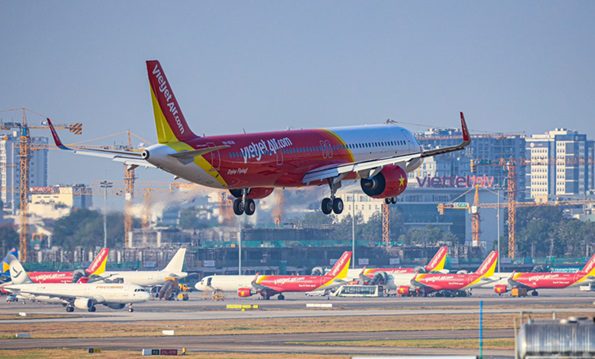![]() In a significant move that underscores its aggressive growth strategy, Vietjet is poised to add 10 cutting-edge aircraft to its modern fleet by the end of 2024. This expansion, amidst a global aviation market grappling with aircraft shortages and surging travel demand, positions Vietjet at the forefront of the industry’s resurgence.
In a significant move that underscores its aggressive growth strategy, Vietjet is poised to add 10 cutting-edge aircraft to its modern fleet by the end of 2024. This expansion, amidst a global aviation market grappling with aircraft shortages and surging travel demand, positions Vietjet at the forefront of the industry’s resurgence.
Vietjet’s fleet will soon be bolstered by adding the latest Airbus A321neo ACF models, a testament to the airline’s commitment to providing superior in-flight experiences. The A321neo ACF, known for its state-of-the-art cabin design, offers passengers enhanced comfort with optimized seat dimensions and spacing. Beyond passenger comfort, these aircraft also align with Vietjet’s sustainability goals, delivering a remarkable 16% fuel savings, slashing noise pollution by up to 75%, and reducing emissions by half.
The first of these aircraft deliveries is expected as early as August 2024, with the remaining units arriving before the year’s close. This move expands Vietjet’s capacity and strengthens its ability to meet the soaring demand on domestic and international routes. With a fleet of over 100 aircraft, including some of the world’s most advanced models like the A320, A321ceo, A321neo, and the A350, Vietjet is setting new benchmarks in safety, efficiency, and environmental stewardship.
Vietjet has been a trailblazer in the aviation industry, the first airline globally to operate the A321neo ACF. The airline’s fleet strategy is driven by a commitment to achieving Net Zero emissions by 2050, a goal that aligns with its broader environmental and social responsibilities. This commitment is not merely about adding numbers; it’s about integrating advanced, eco-friendly aircraft.
The company’s strategic partnership with Airbus further cements its leadership role in the aviation sector. Recently, Vietjet signed a groundbreaking deal to acquire 20 new-generation wide-body A350neo aircraft valued at $7.4 billion. This acquisition will allow Vietjet to introduce longer, safer, and more comfortable flights, particularly on routes that require endurance and reliability.
In the first half of 2024, Vietjet’s performance has been nothing short of spectacular. The airline safely transported 13.1 million passengers across 70,154 flights, a remarkable achievement in a highly competitive market. This operational success translated into robust financial performance, with Vietjet reporting a consolidated revenue of VND34.016 trillion (approximately US$1.35 billion) and a consolidated pre-tax profit of VND1.311 trillion (around US$52.22 million). These figures represent 15% and 433% annual increases, respectively, with profits exceeding the H1 target by 21%.
As Vietjet gears up for the arrival of its new aircraft, the airline is also expanding its network to new horizons. The anticipated fleet expansion will enable Vietjet to launch new routes and strengthen its presence in key markets such as Australia, India, China, Japan, South Korea, Indonesia, Thailand, Singapore, Malaysia, Laos, and Cambodia. This strategic expansion meets the rising demand from local and international travellers and reinforces Vietjet’s role in connecting diverse cultures and fostering global economic growth through tourism and trade.
Vietjet is currently running an exclusive promotion for Australian routes to celebrate its ongoing expansion and entice travellers. Passengers who book Eco fares can enjoy a complimentary 20 kg luggage allowance, making travel more convenient and affordable. This offer is valid until August 15, 2024, with the travel period extending from August 15 to November 30, 2024.
Vietjet’s commitment to growth, sustainability, and customer satisfaction is setting new standards in the aviation industry. As the airline expands its fleet and network, passengers can look forward to more innovative, eco-friendly, and comfortable travel experiences. This fleet expansion is not just about adding planes; it’s about soaring to new heights in service excellence and operational efficiency, ensuring that Vietjet remains a leader in the global aviation landscape.
Written by: My Thanh Pham


















